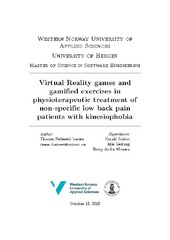| dc.description.abstract | Virtual Reality (VR) hardware has become increasingly cheaper and more available in recent years. Consumer markets, developers and researchers alike have embraced new opportunities to explore novel uses and interactions for this technology, particularly through video games. VR has already been used in various forms of experimental therapy since the early 2000s, including pain modulation and sensory distractions aimed to reduce acute pain experiences, treatment of phobias with graded exposure therapy etc. Recently, this approach has also been considered for experimental use by physio- and manualtherapists’ treatment of chronic low back pain patients. Chronic low back pain is one of the leading causes of debilitating pain conditions, sick leave and healthcare costs worldwide. A subset of these patients will also develop a fear of movement (kinesiophobia) that can be further exacerbating to their condition, despite not having a specific pathology, prevailing injury or danger of re-injury. Maintaining this condition over time can, among other things, lead to increased pain experiences, maladapted cognitive-behavioural patterns and lessened quality of life at the onset of chronicity. Treating this condition has proven difficult, and there is currently little consensus on demonstrably effective treatment regimes. This thesis aims to explore applications of VR games in the domain of physiotherapy, mainly by way of contributing to a clinical trial and research project conducted by physiotherapist and master’s student of health sciences, Maja Sigerseth. The aim of this technological application is to subtly encourage back flexion (through graded exposure) beyond the patients’ maladapted comfort zones while immersed in sensory-distracting exercise games. A prototype game was developed that constituted one third of the stimuli used alongside two commercial titles. Ten patients (n = 10) with non-specific chronic low back and fear of movement participated in the single-subject experimental study, and unstructured observational data was gathered by the author on their interactions with the VR experiences. Health-related outcome measures will be published separately by Sigerseth—forthcoming at the time of writing. Results from the trial observations and two health-domain interviews conducted afterwards suggest that the VR experiences and graded approach are able to encourage back flexion in the relevant areas through exercise games. They provided beneficial sensory distractions such that patients in this group could perform exercises that would typically be avoided due to pain response. The interviews further suggest that the technology and prototype experience may indeed be applicable as tools for treating this patient group, but further research and clinical tailoring is warranted before realistically being deployable to specialized use. | en_US |
